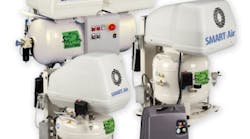by Todd B. Engel, DDS
Oftentimes, patients present with an urgent need for which they seek immediate relief. It is up to the clinician to incorporate the patient's urgent care request into the greater plan, and one that is best for the longevity of the patient's oral health. It doesn't have to be an "all or nothing" or even a Band-Aid method. Creating a long-term approach to treatment not only can meet the needs of patient, but can also eliminate issues that otherwise may produce obstacles down the road for ideal treatment. This process allows both dentist and patient to confidently look forward.
A 52-year-old male patient presents to Dr. Todd Engel at the Ladera Ranch Implant Institute in grave periodontal condition and with all remaining natural teeth unsalvageable (Figure 1). The patient's chief complaint was not only the mobility that led to a significant decline in function, but also public embarrassment due to his negative general appearance and the acute odor that stemmed from his advanced periodontal disease.
Initial assessment
After a thorough examination, a full-mouth digital series of radiographs (Figure 2), and multiple conversations with the patient, a preliminary proposed treatment plan was presented:
- 3-D cone beam scan
- Surgical placement of implants
- Bone regeneration and soft-tissue cosmetic surgery where necessary
- Full maxillary and mandibular removable dentures as an interim solution to restore vertical dimension and natural function
- Full Procera® implant-supported fixed bridges after the patient demonstrates function and comfort
Advanced assessment and treatment planning
A 3-D cone beam scan was accomplished which further confirmed the extent of bone deterioration, and also confirmed the need for extensive bone grafting along the ridge of the maxillary anterior area to achieve a positive result. Using precise 0.8 mm cross-sectional slices, accurate depth and angulation information was ascertained (Figure 3) throughout the entire surgical area, thus allowing implant sites to be determined prior to surgery.
Clinical course
Prior to surgery, it was determined that the location of the existing anterior bridge and central incisors would set the stage for final positioning of the new teeth, and would serve as a surgical guide prior to its removal, based on that orientation.
After carefully relating the radiographic information with all other pertinent clinical data, the proposed surgical locations were marked for future implant sites (Figure 4). To begin, a pilot bur was used to drill through the cingulum (Figure 4) of both central incisor pontics. Leaving the pilot bur in place would serve as a placement marker once the anterior bridge was ultimately removed. Again, this would serve as a surgical stent. (Figure 5). Next, the failing four-unit fixed prosthesis was removed, the surgical sequence continued, and implant placement would follow in the central incisor positions. Continuously incorporating the information from the 3-D scan for positioning would assist in the most ideal and sound implant placement.
The placement of both canine implants was the next surgical step, which was also dictated by the positioning of the patient's natural canines. After the extractions of tooth No. 6 and No. 11, it was determined that the existing sockets allowed for "close to ideal implant placement" with slight socket modifications. These modifications were done with the appropriate surgical burs. Both canine implants were then immediately placed and exhibited a 35 Ncm torque (Figure 6).
Figure 6After placement of the implants, the area was flapped (Figure 7) to facilitate bone grafting where necessary (Figure 8). Additional implants were placed in various sites throughout the maxilla and mandible to lend support to the interim denture following these steps. Because of the pathology and significant resorption of the posterior of the maxilla, some grafting was performed with delayed implant placement to be facilitated with the final phase of treatment.
Figure 7Upon adequate healing (Figure 9), impressions for full maxillary and mandibular removable prostheses were accomplished, as well as subsequent procedures to ensure both a functional and esthetic end result. Ultimately, after all implants and guided tissue regenerative areas exhibit form, strength, and ability to function on load, a full Procera Implant Bridge will be fabricated.
Figure 9The patient reports much improved function and is highly pleased with his new smile (Figure 10). He is looking forward to the next phase of his treatment.
Figure 10Products:
DEXIS® Digital X-ray
Gendex GXCB-500™
Implant system: Nobel Biocare Tapered Groovy's
Bone grafting material: Autogenous Bone, Beta-Tricalcium Phosphate (Cerasorb 150-500 microns)








